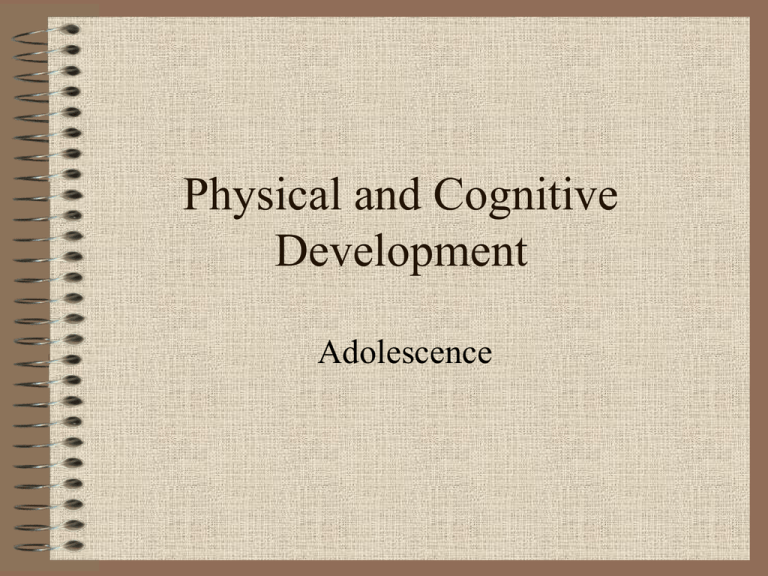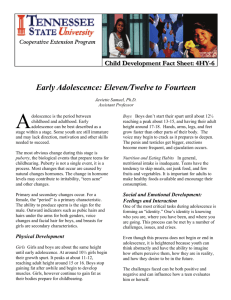Physical and Cognitive Development in Teens
advertisement

Physical and Cognitive Development Adolescence Adolescence • Rousseau and Hall viewed adolescence as a time of great upheaval and turbulence • Freud- the genital stage- period in which instinctive drives reawaken and shift to the genital region. Psychological conflict and volatile, unpredictable behavior • Beginning adolescence is marked by pubertybiological changes that lead to an adult size body and sexual maturity Adolescence and the Environment • Overall rate of severe psychological disturbance rises only slightly from childhood to adolescence- about 20% (emotional disturbance not routine feature of adolescence) • Mead- the social environment was judged to be entirely responsible for the negative and positive experiences in teenagers • Results of Mead’s work- teen years need not be a time of emotional turmoil and greater attention should be paid to social and cultural influences Balanced point of view • Adolescence is both biologically and socially determined • The length of adolescence varies among cultures-simpler societies may have shorter adolescence • Societies that require many years of education for successful economic life have greater extended adolescence period. Puberty • Puberty growth is regulated genetically influenced hormonal processes. • Girls on average reach puberty 2 years earlier than boys • Current research is indicating that girls may be reaching puberty at earlier rates (Time article,Early Puberty) Hormonal Changes • Growth hormone (GH) and thyroxine contribute to the gains in body size and completion of skeletal maturation • Estrogens are typically thought of as female hormones and androgens as male hormones-both types of hormones are present in each sex • Testosterone- the androgen released in large quantities by a boy’s testes- leads to muscle growth, body and facial hair, etc. • Estrogens-development of girl’s breasts, uterus, and vagina; female proportions, accumulation of fat, and beginning of menstrual cycle Puberty Changes-Boys • • • • • • Body size generally complete by 17 ½ yrs Broadening of shoulders Less fat in arms and legs Larger skeletal muscles, heart and lung capacity Spurt in strength, speed and endurance Enlargement of testes and penis- one of 1st signs of puberty; development of pubic and underarm hair • Voice deepens • Spermarche-first ejaculation of seminal fluidabout 13 yrs of age Puberty Changes -Girls • Growth spurt usually complete by 16 • Broadening of hips • Around age 8- start to add more fat in arms legs and trunk • Gross motor development gains are slow and gradual, leveling off at about 14 yrs • Development of breast-one of 1st signs of puberty • Pubic and underarm hair appears • Menarche- first menstruation-about 12 yrs in North American girls Puberty Timing • Heredity is partly responsible for puberty timing • Nutrition and exercise also contribute • Physical health plays a role especially in other poverty-stricken countries • Secular trend-generational change in puberty timing (improvement of health care, diet and sanitation) decrease in menarche age • Secular trend is limited by genetic trend of species Reactions to Puberty • Past generations-traumatic and disturbing • Girls today –mixture of positive and negative emotions-depends on prior knowledge and family members support • Boys know about ejaculation but few get information from parents- most get info from reading material • Boys get less social support • Rite of passage- a community wide event that mark changes in privilege and responsibility • Western culture-little formal recognition Parent-Child Relationships • Bickering and standoffs increase • Physical departure from family and psychological distancing from parents • Adolescence demonstrate new powers of reasoning possible reason for bickering Early vs Late Maturation • Early Maturing boys- relaxed, independent, selfconfident and physically attractive • Early Maturing girls- emotional and social difficulties, withdrawn, lacking self-confidence and psychologically stressed • Late maturing boys- anxious, overly talkative, attention-seeking behavior • Late maturing girls- physically attractive, lively, sociable and leaders in school. • Society favors- girlish shape for girls (late developer) and tall, broad-shouldered and muscular-early developed boys Long Term Consequences Varies among cultures • Early maturing girls and late maturing boys have a difficulty “fitting in” because they are at the extremes of physical development • Teens feel most comfortable with peers that match their own biological maturity • Early maturing teens of both sexes seek out older companions-may have unfavorable consequences • Early maturing boys and late maturing girls admired in teen years may become rigid, conforming and discontented adults • Late maturing boys and early maturing girls less stressed in teen years became independent, flexible and cognitively competent Nutritional Needs of Teens • During growth spurt, boys require about 2,700 calories a day and much more protein • Girls require about 2200 calories and somewhat less protein • Iron deficiency- most common problem in adolescence • Calcium, riboflavin (Vitamin B2) and magnesium may be limited in diet as well • Fad diets are too limited in nutrients and calories to be healthy for teens Eating Disorders • At risk-girls with dissatisfied body images, growing up in economically advantaged homes where cultural concerns are weight and thinness Anorexia nervosa • Parents have high expectations for achievement and social acceptance, overprotective and controlling Anorexia nervosa- individuals starve themselves because of compulsive fear of getting fat; 1 in 50 girls; peak age 14 and 18 Lose between 25% to 50% of body weight and look painfully thin Symptoms- cessation of menstruation, or nonoccurrence of menarche, pale skin, brittle discolored nails, fine dark hair all over body and sensitivity to cold Bulimia • Individuals go on eating binges following by deliberate vomiting, other purging techniques such as heavy doses laxatives and strict dieting • Repeated vomiting causes erosion of tooth enamel, and can cause life threatening damage to the throat and stomach • More common than anorexia, 5% bulimic girls have previously been anorexic • Bulimic are not just impulsive eaters; they lack self-control in other areas of their lives • Abnormal eating habits, feeling depressed, and guilty about eating-usually easier to treat than anorexia Sexual Activity • American parents typically give children little information about sex, discourage them from engaging in sex play and rarely talk about sex in their presence. • Teens may receive contradictory and confusing messages about sex. • Adults emphasize that sex at a young age and outside if marriage is wrong; Broader social environments emphasizes the excitement and romanticism of sex • Over past 30 years sexual attitudes are more liberal Sexually Active Teens • Linked to –early physical maturation, parental separation and divorce, large family size, sexually activity of friends, and older siblings, poor school performance, lower educational aspirations, and tendency to engage in norm-violating acts Sexual Orientation • 3 to6 % of young people discover they are lesbian or gay • Heredity may contribute to homosexuality • Stereotypes and misconceptions continue to be widespread STDs • Sexually Transmitted Diseases (STDS) are highest among teens 1 out 6 each year • Teens at greatest danger- poverty stricken teens with sense of hopelessness Most serious STD- Acquired Immunodeficiency Syndrome (AIDS) Teen Pregnancy • >900,00 teens get pregnant in US 30,000 are under 15years Teen Moms • • • • Less likely to finish high school Less likely to get married More likely to be on welfare Babies are more likely to have prenatal problems,complications and LBW • Know less about Child Development, positive parenting, and proper interaction with babies Community Prevention of Teen Pregnancy • Inform teens about facts of anatomy, sex and reproduction • Promote abstinence and provide information about birth control • Encourage teens to look forward to promising future Substance Abuse • By 14 yrs of age, 56% teens have already tried smoking • 81% drinking, 39% at least one illegal drug • Majority are substance experimenters are psychologically healthy, sociable and inquisitive Substance Abusers • • • • • • Troubled teens Peer encouragement Mental health problems Family drug use Lack of parental involvement Poor school performance Prevention • School-based programs promoting effective parenting, educating students about drugs and dangers. • Teaching teens to resist peer pressure • There is a relapse rate Cognitive Development • Piaget’s –formal operational stage-abstract scientific thinking • Hypothetico-deductive reasoning- problem solving strategy- begins with general theory and deduce specific hypotheses which is tested • Concrete operational children experiment unsystematically. Formal Operation Stage • Propositional thought-formal operational reasoning in which teens assess logic of verbal statements without referring to realworld circumstances • Piaget agreed that language plays a significant part of adolescent development due to reasoning about abstract concepts Formal Operations • About 40% to 60% of college students fail Piaget’s formal operational problems • Abstract thinking comes from extensive experience in that area • Some villages and tribal societies do not include formal operations Cognitive Development of Teens • Can argue more effectively (page 374) • Become more self-conscious and selffocused (374-375) • Become more idealistic and critical (375376) • Become better at everyday planning and decision making (376)



